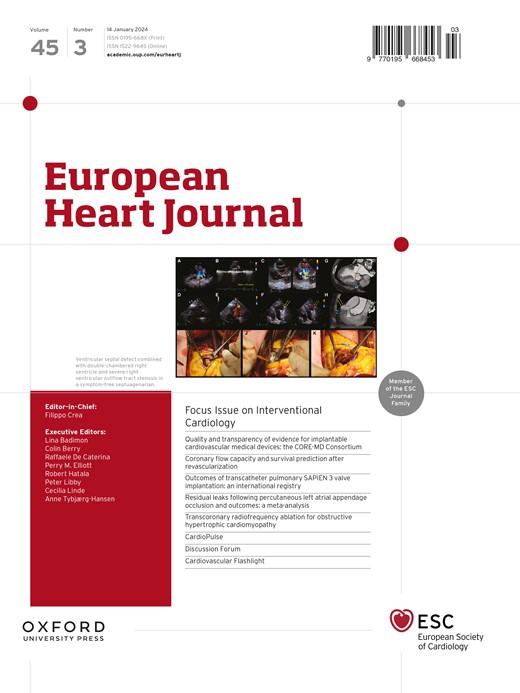Optical coherence tomography- vs angiography-guided coronary stent implantation in calcified lesions: the ILUMIEN IV trial
IF 37.6
1区 医学
Q1 CARDIAC & CARDIOVASCULAR SYSTEMS
引用次数: 0
Abstract
Background and Aims The large-scale, randomized ILUMIEN IV trial was examined to determine whether procedural guidance with optical coherence tomography (OCT) during percutaneous coronary intervention (PCI) of angiographically calcified lesions improves outcomes. Methods Patients with a single PCI target lesion were included in the present analysis. The presence of none, mild, moderate or severe lesion calcification was determined by an angiographic core laboratory. The primary imaging endpoint was the post-PCI minimal stent area (MSA) assessed by OCT. The primary clinical endpoint was 2-year target-vessel failure (TVF), a composite of cardiac death, target-vessel myocardial infarction (TV-MI), or ischaemia-driven target-vessel revascularization. Results In the overall population (n = 2114), there was a significant interaction between the effect of randomization to OCT guidance vs angiography guidance in lesions with moderate/severe calcification (n = 1082) vs no/mild calcification (n = 1032) on the 2-year rate of TVF (Pinteraction = .01). The post-PCI MSA in moderately and severely calcified lesions was larger with OCT guidance (n = 544) compared with angiography guidance (n = 538) (5.57 ± 1.86 mm2 vs 5.33 ± 1.78 mm2; P = .03). In the moderate/severe calcified lesion cohort, TVF within 2 years occurred in 35 patients with OCT guidance and in 51 patients with angiography guidance (6.8% vs 9.7%; adjusted hazard ratio [aHR] 0.62; 95% confidence interval [CI] 0.40–0.96), whereas there was no significant difference in TVF in the no/mild calcified lesion cohort (7.7% vs 5.2%; aHR 1.48; 95% CI 0.90–2.44) (Pinteraction = .01). In moderately/severely calcified lesions, OCT-guided PCI also reduced the 2-year rates of serious major adverse cardiac events (2.8% vs 4.7%; aHR 0.49; 95% CI 0.25–0.95; P = .03), TV-MI (1.9% vs 4.0%; aHR 0.36; 95% CI 0.17–0.79; P = .01), and stent thrombosis (0.2% vs 1.5%; aHR 0.11; 95% CI 0.01–0.89; P = .04) compared with angiography-guided PCI. Conclusions In the ILUMIEN IV trial, OCT-guided PCI in patients with angiographically determined moderately or severely calcified lesions reduced the 2-year rate of TVF compared with angiography-guided PCI, an effect that was not seen in patients with lesions with no or mild angiographic calcium.光学相干断层扫描vs血管造影引导冠状动脉支架植入钙化病变:ILUMIEN IV试验
背景和目的大规模、随机的ILUMIEN IV试验旨在确定在经皮冠状动脉介入治疗(PCI)血管造影钙化病变时,光学相干断层扫描(OCT)的程序指导是否能改善预后。方法选取单PCI靶病变患者为研究对象。通过血管造影中心实验室确定无、轻度、中度或重度病变钙化的存在。主要影像学终点为pci后最小支架面积(MSA),主要临床终点为2年靶血管衰竭(TVF),心源性死亡、靶血管心肌梗死(TV-MI)或缺血驱动的靶血管重建术。结果在总体人群(n = 2114)中,在中度/重度钙化病变(n = 1082)与无/轻度钙化病变(n = 1032)中,随机化OCT指导与血管造影指导对2年TVF发生率的影响显著相互作用(p相互作用= 0.01)。中重度钙化病变的pci后MSA在OCT引导下(n = 544)大于血管造影引导下(n = 538)(5.57±1.86 mm2 vs 5.33±1.78 mm2;P = .03)。在中/重度钙化病变队列中,35例在OCT指导下发生了2年内的TVF, 51例在血管造影指导下发生了TVF (6.8% vs 9.7%;调整风险比[aHR] 0.62;95%可信区间[CI] 0.40-0.96),而无/轻度钙化病变组的TVF无显著差异(7.7% vs 5.2%;aHR 1.48;95% CI 0.90-2.44) (p交互作用= 0.01)。在中度/重度钙化病变中,oct引导下的PCI也降低了2年内严重主要不良心脏事件的发生率(2.8% vs 4.7%;aHR 0.49;95% ci 0.25-0.95;P = .03), TV-MI (1.9% vs 4.0%;aHR 0.36;95% ci 0.17-0.79;P = 0.01),支架血栓形成(0.2% vs 1.5%;aHR 0.11;95% ci 0.01-0.89;P = .04)。结论:在ILUMIEN IV试验中,与血管造影确定的中度或重度钙化病变患者相比,oct引导下的PCI可降低2年TVF发生率,这一效果在无或轻度血管造影钙化病变患者中未见。
本文章由计算机程序翻译,如有差异,请以英文原文为准。
求助全文
约1分钟内获得全文
求助全文
来源期刊

European Heart Journal
医学-心血管系统
CiteScore
39.30
自引率
6.90%
发文量
3942
审稿时长
1 months
期刊介绍:
The European Heart Journal is a renowned international journal that focuses on cardiovascular medicine. It is published weekly and is the official journal of the European Society of Cardiology. This peer-reviewed journal is committed to publishing high-quality clinical and scientific material pertaining to all aspects of cardiovascular medicine. It covers a diverse range of topics including research findings, technical evaluations, and reviews. Moreover, the journal serves as a platform for the exchange of information and discussions on various aspects of cardiovascular medicine, including educational matters.
In addition to original papers on cardiovascular medicine and surgery, the European Heart Journal also presents reviews, clinical perspectives, ESC Guidelines, and editorial articles that highlight recent advancements in cardiology. Additionally, the journal actively encourages readers to share their thoughts and opinions through correspondence.
 求助内容:
求助内容: 应助结果提醒方式:
应助结果提醒方式:


